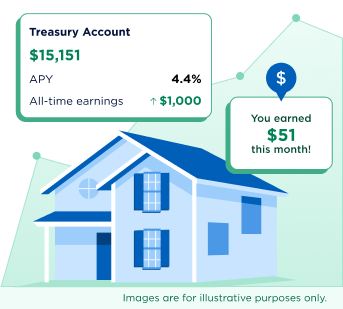What’s the Average Down Payment on a House?
Younger and first-time buyers make smaller down payments than older buyers — and less than 20% is totally normal.

Some or all of the mortgage lenders featured on our site are advertising partners of NerdWallet, but this does not influence our evaluations, lender star ratings or the order in which lenders are listed on the page. Our opinions are our own. Here is a list of our partners.
The median down payment for all home buyers is 19%, according to the National Association of Realtors (NAR).
First-time buyers make smaller down payments: They put down a median 10%, compared to 23% for repeat buyers.
In dollars, the median down payment on a median-priced home is $78,888, using NAR data from October 2025.
If you’re saving for a down payment, it’s normal to wonder if you have enough money in the bank. There’s no one-size-fits-all answer, but comparing your savings to the average down payment can be a good gut check. (Some encouraging news: Just about everyone is putting down less than 20%.)
The average down payment varies widely by location, age group and whether someone has owned a house before. Let’s examine a few different sources of data to see how much money people are putting down on houses across the U.S.
Treasury Bills or HYSA: Which grows your down payment faster?
With yields that beat most high-yield savings accounts, the Atomic Treasury account can offer a smarter way to save. Plus, earned interest is exempt from state and local taxes.

What is the typical down payment on a house?
All home buyers: 19%
First-time home buyers: 10%
Repeat home buyers: 23%
In 2025, the median percent down payment for all home buyers was 19%, according to the 2025 Profile of Home Buyers and Sellers from the National Association of Realtors. First-time home buyers, at a median age of 40, put down a little less than repeat buyers. At a median age of 62, repeat buyers have had two more decades to build wealth and home equity.
A quick refresher from math class: “Average” and “median” are calculated a little bit differently. An average can be skewed by high and low extremes, so it can be less representative of what most folks actually pay. The median is often a more accurate measure of the true middle.
Median down payment on a house (in dollars)
What do those percentages mean in real money? Let’s do some math. The median existing-home sales price in October 2025 was $415,200, according to the NAR. Using that price as an example, here’s what those median down payment percentages look like:
10% down (first-time buyers): $41,520
19% down (all buyers): $78,888
23% down (repeat buyers): $95,496
If these numbers seem steep, remember the amounts will be lower for a house below this price point. After all, plenty of people — especially first-time home buyers — are house-hunting below the $400,000 mark.
Here’s what those median down payment percentages look like for a house that costs $269,000, about the median price for a home in Pittsburgh (according to Realtor.com).
10% down (first-time buyers): $26,900
19% down (all buyers): $51,110
23% down (repeat buyers): $61,870
You don’t need to put 20% down to buy a house. That’s just the cutoff many lenders use for requiring private mortgage insurance (PMI) on a conventional loan. If you put less than 20% down, leave some wiggle room in your budget to account for the cost of monthly mortgage insurance payments.
Median down payment by age
Generally speaking, older buyers make larger down payments than younger buyers. As you build wealth (including home equity) over time, you might have a little more to apply toward a down payment.
Here is the median down payment by age group, according to the NAR 2025 Home Buyers and Sellers Generational Trends Report.
Age group | Median down payment |
|---|---|
All buyers | 15% |
Age 26-34 | 10% |
Age 35-44 | 14% |
Age 45-59 | 17% |
Age 60-69 | 28% |
Age 70-78 | 36% |
Age 79-99 | 38% |

Average down payment by state
Housing prices — and down payments — vary widely depending on where you live. Let’s take a look at the data by state, according to Q3 2025 data compiled by the research team at Realtor.com.
Places with the highest median down payments (in dollars)
California: $96,364
New Jersey: $89,797
Washington: $82,974
Places with the lowest median down payments (in dollars)
Mississippi: $5,887
West Virginia: $7,517
Louisiana: $7,577
Here is the full list of the average down payment (as a percentage) and the median down payment (as a dollar amount), according to Realtor.com.
State | Average down payment (percentage) | Median down payment (dollars) |
|---|---|---|
Alabama | 10.7% | $8,388 |
Alaska | 11.5% | $24,608 |
Arizona | 13.6% | $28,340 |
Arkansas | 11.4% | $12,784 |
California | 18.3% | $96,364 |
Colorado | 17.7% | $71,601 |
Connecticut | 18.2% | $63,438 |
Delaware | 18.0% | $49,047 |
District of Columbia | 18.6% | $87,100 |
Florida | 13.4% | $22,077 |
Georgia | 11.6% | $14,438 |
Hawaii | 17.8% | $73,617 |
Idaho | 18.4% | $54,567 |
Illinois | 14.8% | $33,985 |
Indiana | 13.2% | $19,761 |
Iowa | 17.0% | $33,318 |
Kansas | 13.5% | $24,383 |
Kentucky | 13.3% | $19,627 |
Louisiana | 9.8% | $7,577 |
Maine | 17.2% | $45,619 |
Maryland | 12.5% | $27,543 |
Massachusetts | 18.8% | $80,533 |
Michigan | 14.5% | $27,241 |
Minnesota | 16.2% | $40,428 |
Mississippi | 8.8% | $5,887 |
Missouri | 12.6% | $18,733 |
Montana | 19.4% | $59,917 |
Nebraska | 16.0% | $32,125 |
Nevada | 14.5% | $34,720 |
New Hampshire | 20.8% | $79,083 |
New Jersey | 19.8% | $89,797 |
New Mexico | 12.0% | $16,092 |
New York | 18.1% | $59,718 |
North Carolina | 14.0% | $26,280 |
North Dakota | 14.1% | $26,406 |
Ohio | 12.7% | $18,297 |
Oklahoma | 11.8% | $13,251 |
Oregon | 16.8% | $53,877 |
Pennsylvania | 15.1% | $33,265 |
Rhode Island | 17.9% | $61,044 |
South Carolina | 14.2% | $19,166 |
South Dakota | 13.4% | $23,125 |
Tennessee | 13.6% | $21,315 |
Texas | 10.7% | $12,262 |
Utah | 15.5% | $42,863 |
Vermont | 18.5% | $53,467 |
Virginia | 13.9% | $32,652 |
Washington | 17.9% | $82,974 |
West Virginia | 9.7% | $7,517 |
Wisconsin | 16.0% | $37,203 |
Wyoming | 14.3% | $23,131 |
What percent down payment do you need for a house?
When you’re ready to buy, you don’t need to put 20% down. See if you qualify for these ways to help you stretch your savings.
Low-down-payment mortgages
If a smaller down payment is more reasonable for your budget, you have options.
Conventional loans: Some of today’s conventional loans allow down payments as low as 3%.
FHA loans: These mortgages, backed by the Federal Housing Administration, offer down payments as low as 3.5%.
VA loans and USDA loans: If you qualify for one of these 0% down mortgages, you won’t need a down payment at all — though you are still on the hook for closing costs and fees.
» MORE: Best FHA lenders
Down payment assistance programs
In some cases, you don’t have to pay for your whole down payment by yourself. You might qualify for down payment or closing cost assistance. These funds are offered through state or local governments, as well as nonprofit organizations.
Read the fine print to see if you qualify. Most programs are designed for low- to middle-income borrowers who are buying a home for the first time.
What’s a good down payment for a house?
Short answer: As much as you’re comfortably able to contribute.
A good down payment isn’t so high that it drains your savings or so low that you can’t afford the monthly mortgage payment.
In general: A higher down payment means a less expensive mortgage. When you put more money down, a mortgage lender will charge less in interest rates and fees.
Even with a smaller down payment, a house is a big investment. A good first step is to see if renting vs. buying makes more sense for your budget right now. If you’re early in your savings journey, it might be worth it to spend time socking some money away before you start your house hunt.
More from NerdWallet





